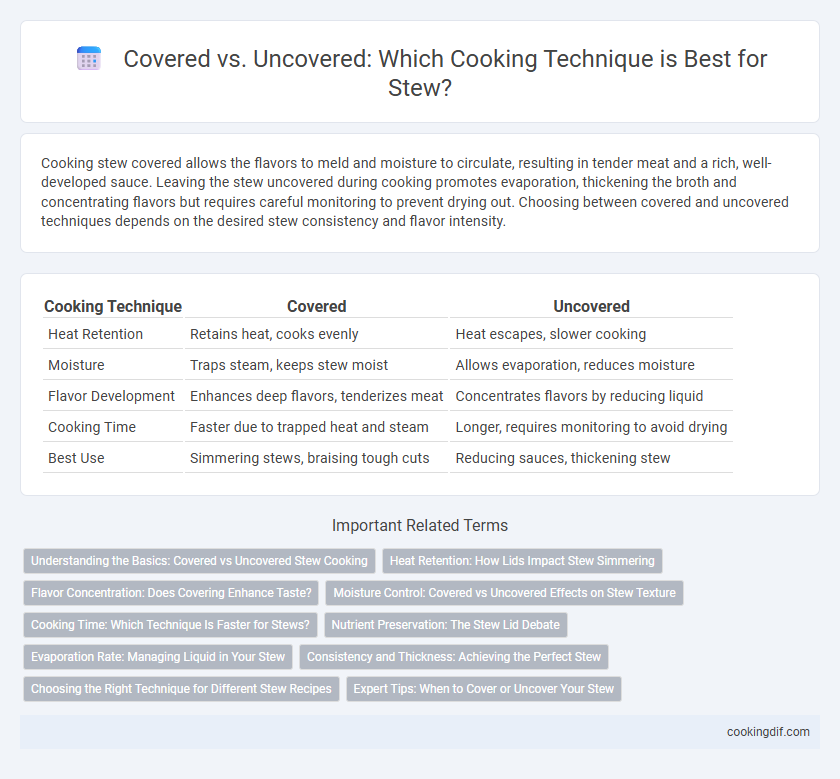Cooking stew covered allows the flavors to meld and moisture to circulate, resulting in tender meat and a rich, well-developed sauce. Leaving the stew uncovered during cooking promotes evaporation, thickening the broth and concentrating flavors but requires careful monitoring to prevent drying out. Choosing between covered and uncovered techniques depends on the desired stew consistency and flavor intensity.
Table of Comparison
| Cooking Technique | Covered | Uncovered |
|---|---|---|
| Heat Retention | Retains heat, cooks evenly | Heat escapes, slower cooking |
| Moisture | Traps steam, keeps stew moist | Allows evaporation, reduces moisture |
| Flavor Development | Enhances deep flavors, tenderizes meat | Concentrates flavors by reducing liquid |
| Cooking Time | Faster due to trapped heat and steam | Longer, requires monitoring to avoid drying |
| Best Use | Simmering stews, braising tough cuts | Reducing sauces, thickening stew |
Understanding the Basics: Covered vs Uncovered Stew Cooking
Covered stew cooking traps moisture and heat, resulting in tender, flavorful meat and well-blended ingredients through gentle simmering. Uncovered stewing allows liquid to reduce and intensifies flavors by evaporation, creating a thicker, more concentrated sauce. Mastering when to cover or uncover during different cooking stages enhances texture and depth in traditional stew recipes.
Heat Retention: How Lids Impact Stew Simmering
Using a lid while cooking stew significantly enhances heat retention by trapping steam and maintaining a consistent simmering temperature. Covered cooking reduces moisture loss, preventing the stew from drying out and ensuring flavors meld more effectively. In contrast, an uncovered pot allows heat escape, leading to longer cooking times and potential uneven simmering.
Flavor Concentration: Does Covering Enhance Taste?
Covering a stew during cooking traps steam and moisture, intensifying flavors by allowing ingredients to meld and reducing liquid evaporation. An uncovered stew experiences more evaporation, concentrating flavors but risking dryness and uneven cooking. For optimal taste, a covered stew maintains balanced moisture and richness, while brief uncovered simmering can further concentrate flavors without sacrificing texture.
Moisture Control: Covered vs Uncovered Effects on Stew Texture
Cooking stew covered traps steam and moisture, resulting in tender, juicy meat and a thicker, more cohesive sauce. Leaving the stew uncovered allows moisture to evaporate, concentrating flavors but producing a thicker, less fluid texture with firmer ingredients. Moisture control through covering directly influences the stew's consistency and mouthfeel, balancing tenderness against intensity of flavor.
Cooking Time: Which Technique Is Faster for Stews?
Uncovered stews cook faster due to higher evaporation rates that concentrate flavors and reduce liquid volume more quickly, typically taking around 1 to 2 hours. Covered stews trap steam and heat, creating a moist environment that slows evaporation, resulting in cooking times of 2 to 3 hours but producing more tender meat. Choosing uncovered cooking is ideal for quicker results, while covered cooking enhances depth of flavor and tenderness over extended simmering periods.
Nutrient Preservation: The Stew Lid Debate
Using a lid while cooking stew helps retain heat and moisture, preserving water-soluble vitamins like vitamin C and B-complex that might otherwise evaporate. Uncovered stewing allows excess moisture to escape, concentrating flavors but increasing nutrient loss due to prolonged exposure to air and heat. Balancing covered cooking with occasional lid removal can optimize nutrient retention while enhancing taste in stew preparation.
Evaporation Rate: Managing Liquid in Your Stew
Cooking a stew with a covered pot significantly reduces evaporation rate, helping retain moisture and intensify flavors by trapping steam. An uncovered stew allows more evaporation, concentrating flavors but requiring frequent liquid monitoring to prevent drying out. Balancing these evaporation rates controls stew consistency and ensures optimal texture and taste.
Consistency and Thickness: Achieving the Perfect Stew
Covered cooking traps steam, maintaining moisture and creating a thicker, more consistent stew as flavors meld evenly. Uncovered cooking allows liquid to evaporate, resulting in a thinner broth with a more concentrated taste but less uniform texture. Balancing lid use during cooking controls the stew's final thickness and consistency to match personal preference.
Choosing the Right Technique for Different Stew Recipes
Selecting a covered cooking technique for stew retains moisture and intensifies flavors through slow simmering, ideal for hearty cuts and root vegetables. Uncovered stewing suits recipes requiring reduction and thickening, allowing excess liquid to evaporate and concentrate the broth. Understanding the specific stew recipe, ingredient texture, and desired sauce consistency guides the choice between covered or uncovered techniques, ensuring optimal taste and presentation.
Expert Tips: When to Cover or Uncover Your Stew
Covering a stew traps moisture and heat, promoting tender meats and rich flavors through slow, even cooking. Uncovered cooking allows evaporation, concentrating flavors and thickening the broth for a more robust stew. Experts recommend covering during the initial long simmer to soften ingredients, then uncovering near the end to reduce liquid and intensify taste.
Covered vs Uncovered for Cooking Technique Infographic

 cookingdif.com
cookingdif.com